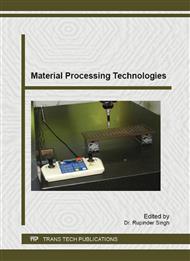[1]
Ezugwu, E.O.; Wang, Z.M., Titanium alloys and their machinability—A review. Journal of Materials Processing Technology 1997, 68, 262–274.
DOI: 10.1016/s0924-0136(96)00030-1
Google Scholar
[2]
Yan, B.H.; Tsai, H.C.; Huang, F.Y., The effect in EDM of a dielectric of a urea solution in water on modifying the surface of titanium. International Journal of Machine Tools & Manufacture 2005, 45, 194–200.
DOI: 10.1016/j.ijmachtools.2004.07.006
Google Scholar
[3]
Ho K. H.; Newman, S. T., State of the art electrical discharge machining. International Journal of Machine Tools & Manufacture 2003, 43, 1287-1300.
DOI: 10.1016/s0890-6955(03)00162-7
Google Scholar
[4]
Ahmet, Hascalik; Ulas, Caydas, Electric discharge machining of titanium alloy (Ti-6Al-4V), Applied Surface Science 2007, 253, 9007-9016.
DOI: 10.1016/j.apsusc.2007.05.031
Google Scholar
[5]
Soni, J.S.; Chakraverti, G., Machining characteristics of titanium with rotary electro-discharge machining. Wear 1994, 171, 51-58.
DOI: 10.1016/0043-1648(94)90347-6
Google Scholar
[6]
Yan, C.L.; Biing, H.Y.; Yong, S.C., Machining characteristics of titanium alloy (Ti-6Al-4V) using a combination process of EDM with USM. Journal of Materials Processing Technology 2000, 104, 171–177.
DOI: 10.1016/s0924-0136(00)00539-2
Google Scholar
[7]
Ho, S.K.; Aspinwall, D.K.; Voice, W., Use of powder metallurgy (PM) compacted electrodes for electrical discharge surface alloying/modification of Ti–6Al–4V alloy. Journal of Materials Processing Technology 2007, 191, 123–126.
DOI: 10.1016/j.jmatprotec.2007.03.003
Google Scholar
[8]
Bai, C.Y.; Koo, C.H., Effects of kerosene or distilled water as dielectric on electrical discharge alloying of superalloy Haynes 230 with Al-Mo composite electrode. Surface Coating Technology 2006, 200 (12–13), 4127–4315.
DOI: 10.1016/j.surfcoat.2005.03.022
Google Scholar
[9]
Pradhan, B. B.; Masanta, M.; Sarkar, B. R.; Bhattacharyya, B., Investigation of electro-discharge micro-machining of titanium super alloy. International Journal of Advanced Manufacturing Technology 2009, 41, 1094-1106.
DOI: 10.1007/s00170-008-1561-y
Google Scholar
[10]
Caydas, U.; Hascalik, A., Modeling and analysis of electrode wear and white layer thickness in die-sinking EDM process through response surface methodology. International Journal of Advanced Manufacturing Technology 2008, 38, 1148–1156.
DOI: 10.1007/s00170-007-1162-1
Google Scholar
[11]
Kao, J.Y.; Tsao, C.C.; Wang, S.S.; Hsu, C.Y., Optimization of the EDM parameters on Ti-6Al-4V with multiple quality characteristics. International Journal of Advanced Manufacturing Technology 2010, 47: 395–402.
DOI: 10.1007/s00170-009-2208-3
Google Scholar
[12]
Jabbaripour, B.; Sadeghi, M.H.; Faridvand. Sh.; Shabgard, M.R. Investigating the Effects of EdM Parameters on Surface Integrity, MRR and TWR in Machining of Ti–6Al–4V. Machining Science and Technology: An International Journal 2012, 16, 419–444.
DOI: 10.1080/10910344.2012.698971
Google Scholar
[13]
Sidhu, S. S.; Kumar, S., Batish, A., Electric discharge machining of 10Vol% Al2O3/al metal matrix composite – an experimental study. Materials Science Forum 2013, 751, 9-19.
DOI: 10.4028/www.scientific.net/msf.751.9
Google Scholar
[14]
Khan, D.A.; Hameedullah, M., Effect of tool polarity on the machining characteristics in electric discharge machining of silver steel and statistical modeling of the process. International Journal of Engineering Science and Technology 2011, 3 (6), 5001-5010.
Google Scholar
[15]
Kumar, S.; Batish, A.; Singh, R.; Singh, T.P., A hybrid Taguchi-artificial neural network approach to predict surface roughness during electric discharge machining of titanium alloys. Journal of Mechanical Science and Technology 2014, 28 (7), 2831-2844.
DOI: 10.1007/s12206-014-0637-x
Google Scholar
[16]
Kumar, S.; Batish, A.; Singh, R.; Singh, T.P., A mathematical model to predict material removal rate during electric discharge machining of cryogenically treated titanium alloy. Proceedings of Institutions of Mechanical Engineering, Part B: Journal of Engineering Manufacture 2015, 229 (2), 214-228.
DOI: 10.1177/0954405414527955
Google Scholar
[17]
Muttamara, A.; Fukuzawa F.; Mohri N.; Tani, T., Effect of electrode material on electrical discharge machining of alumina. Journal of Materials Processing Technology 2009, 209, 2545–2552.
DOI: 10.1016/j.jmatprotec.2008.06.018
Google Scholar
[18]
Hourmand, M.; Farahany, S.; Srahan, Ahemed A.D.; Noordin, M.S., Investigating the electrical discharge machining (EDM) parameter effects on Al-Mg2Si metal matrix composite (MMC) for high material removal rate (MRR) and less EWR–RSM approach. International Journal of Advanced Manufacturing Technology 2015, 77 (5-8): 831-838.
DOI: 10.1007/s00170-014-6491-2
Google Scholar


